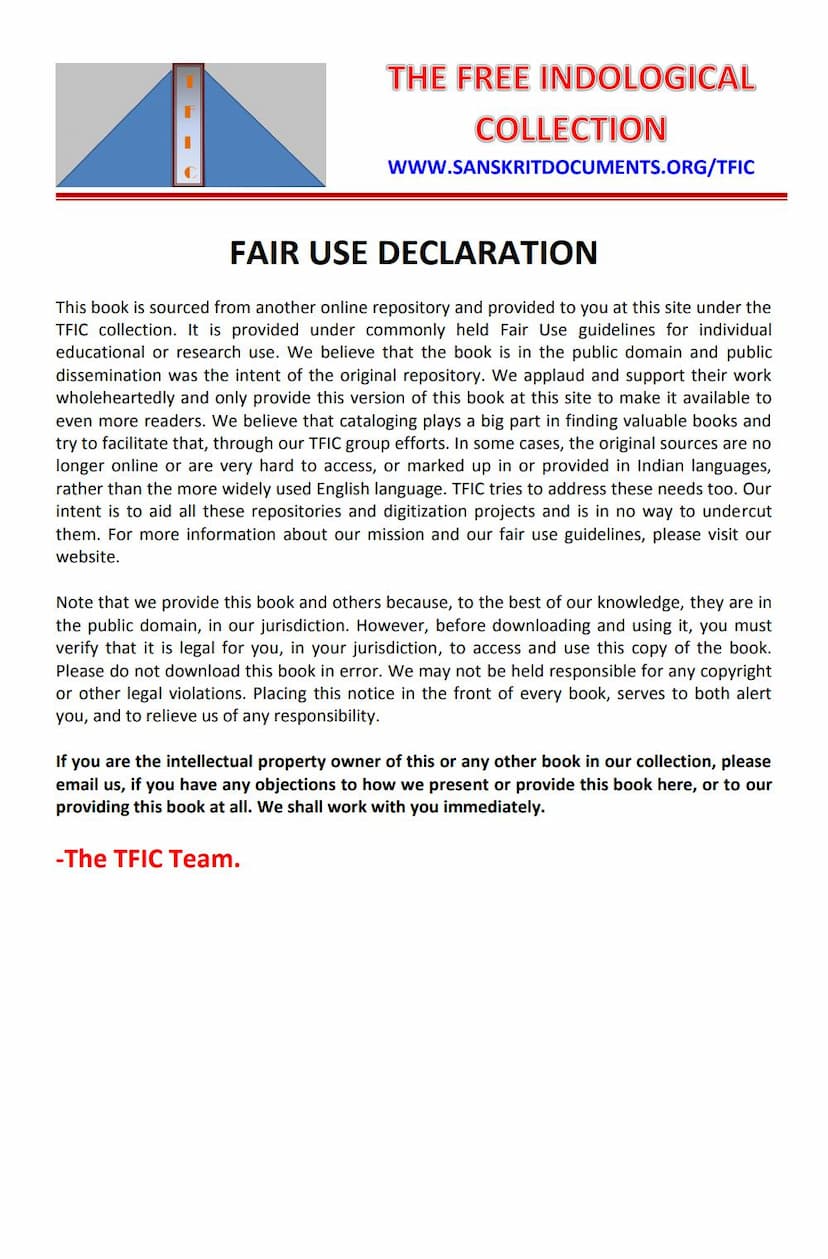Jain Pratima Vigyan
Added to library: September 2, 2025

Summary
This is a comprehensive summary of the Jain text "Jain Pratima Vigyan" by Balchand Jain, based on the provided catalog link and text excerpts:
Book Title: Jain Pratima Vigyan (with Pratimalakshan - Iconography) Author: Balchand Jain, M.A., Sahityashastri, Deputy Director, Archaeology & Museums, Madhya Pradesh Publisher: Madanmahal General Stores, Jabalpur Publication Year: Vira Nirvana Samvat 2500 / 1974 AD
Overall Objective and Content:
"Jain Pratima Vigyan" is a detailed study of Jain iconography and the science of image-making within the Jain tradition. It aims to provide a thorough understanding of the principles and practices related to the creation, consecration, and worship of Jain images (pratimas). The book covers both Digambara and Shvetambara traditions, drawing upon various scriptural and traditional sources.
Key Themes and Chapters:
The book is structured into several chapters, each delving into specific aspects of Jain iconography:
- Chapter 1: Foundation Texts of Jain Iconography: This chapter discusses foundational Jain texts relevant to iconography, the significance of revered beings (Arhats, Siddhas, Acharyas, Kevalins), and the concept of auspiciousness. It also touches upon the antiquity of Jain image-making, referencing archaeological evidence and ancient Jain literature.
- Chapter 2: Jain Temples and Images: This section focuses on temple construction, ideal locations, materials used for image creation, and the classification of images (pujya - worshipped, apujya - not worshipped, and magna - broken). It also begins to discuss the specific characteristics of Arhat, Siddha, Acharya, and Kevalin images.
- Chapter 3: Talman (Proportional System): This chapter is dedicated to the crucial concept of Talman, the proportional system used in Indian art for determining the measurements and proportions of sculptures. It discusses various units of measurement and how they are applied to different types of postures like Kayotsarga (standing) and Padmasana (seated) images, as well as the proportions of pedestals (simhasan) and aureoles (parikar).
- Chapter 4: Timeless Eras and Tirthankaras: This chapter delves into the Jain cosmology and history, discussing concepts like Kalarachana (time cycles), the Chaturvinshati Tirthankaras (24 Tirthankaras), their lineage, birth details, associated trees, Samavasharan (divine assembly), attendants (pratihar), liberation sites (nirvana-bhumi), and the concept of Navadevata (nine divine beings). It also elaborates on the Ashta Pratiharya (eight auspicious signs of divinity) and Ashta Mangal Dravya (eight auspicious substances).
- Chapter 5: Chatur-Nikaya Devas (Four Classes of Deities): This chapter discusses the cosmological hierarchy of deities in Jainism, classifying them into four groups: Bhavanavasi (dwelling deities), Vyantara (intermediate deities), Jyotishka (celestial deities), and Vaimanika (vimana-dwelling deities). It also details their respective Indras (chiefs).
- Chapter 6: Vidya Devis (Goddesses of Knowledge): This chapter focuses on the sixteen Vidya Devis, with a particular emphasis on Shruta-devi (Saraswati), who is considered the presiding deity of knowledge and scripture. It details their iconography, including their attributes, vehicles, and forms, as described in various Jain texts.
- Chapter 7: Shasan Devis (Guardian Deities): This chapter extensively discusses the Shasan Devas and Shasan Devis, particularly the twenty-four Yakshas and twenty-four Yakshinis associated with each Tirthankara. It analyzes their iconography, origins (including influences from Hinduism and Buddhism), and provides detailed descriptions of prominent Yakshas and Yakshinis, their attributes, vehicles, and forms.
- Chapter 8: Kshetrapala (Guardian of the Site): This chapter discusses the iconography of Kshetrapala, who are considered guardians of Jain temples and sites. It details their fierce appearance, various forms, associated animals, weapons, and worship rituals.
- Chapter 9: Ashta Matrikas (Eight Mother Goddesses): This chapter describes the iconography of the eight Matrikas (Indrani, Vaishnavi, Kaumari, Varahi, Brahmani, Mahalakshmi, Chamunda, and Bhavani), who are worshipped in various directions. It notes the similarities and slight variations in their descriptions from Hindu traditions.
- Chapter 10: Dash Dikpala (Ten Guardians of Directions): This chapter covers the ten Dikpalas, the directional guardians in Jainism. It includes their traditional counterparts, their associated directions, colors, vehicles, weapons, wives, and divine attendants, highlighting unique Jain interpretations.
- Chapter 11: Nava Graha (Nine Planets): This chapter explains the iconography of the nine planets (Nava Graha) within the Jain framework. It discusses their association with specific Tirthankaras, their directions, colors, vehicles, and weapons, and how they were integrated into Jain worship practices.
Key Contributions and Significance:
- Comprehensive Scope: The book covers a vast array of deities and iconographic elements within Jainism, drawing from both major traditions.
- Interdisciplinary Approach: It bridges textual analysis with archaeological findings and artistic representations.
- Detailed Iconographic Descriptions: The text provides specific details on the physical attributes, postures, weapons, vehicles, and symbolic meanings of various Jain deities and figures.
- Historical Perspective: It traces the evolution of Jain iconography and the incorporation of certain deities and practices under the influence of broader Indian cultural and religious trends.
- Comparative Study: By comparing Digambara and Shvetambara perspectives, the book offers a nuanced understanding of the Jain tradition.
- Reference Work: "Jain Pratima Vigyan" serves as an invaluable reference for scholars, artists, art historians, and devotees interested in Jain art and iconography.
In essence, "Jain Pratima Vigyan" is a scholarly and systematic exploration of Jain visual culture, providing a deep dive into the "science" behind the creation and meaning of Jain images, reflecting the rich artistic and spiritual heritage of Jainism.